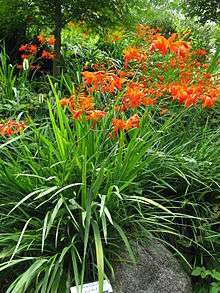Crocosmia × crocosmiiflora
Crocosmia × crocosmiiflora, montbretia, is a garden hybrid of C. aurea and C. pottsii, first bred in 1880 in France by Victor Lemoine.[1] The name "montbretia" is often found in horticultural literature.[2]
| Crocosmia × crocosmiiflora | |
|---|---|
 | |
| Scientific classification | |
| Kingdom: | Plantae |
| Clade: | Tracheophytes |
| Clade: | Angiosperms |
| Clade: | Monocots |
| Order: | Asparagales |
| Family: | Iridaceae |
| Genus: | Crocosmia |
| Species: | C. × crocosmiiflora |
| Binomial name | |
| Crocosmia × crocosmiiflora (Lemoine) N.E.Br. | |
Description
Crocosmia × crocosmiiflora grows to 90 cm high with long sword-shaped leaves, shorter than the flowering stem and arising from the plant base, ribbed and up to 20mm wide.[1] The base is a corm, a swollen underground stem lasting one year. The flowers are up to 5 cm long and coloured deep orange.[3]
Cultivation
In the United States, Crocosmia × crocosmiiflora is considered suitable for planting in hardiness zones 5–9, but in more northerly locations it can be planted in the spring and the corms dug out in the fall. The corms should be planted in a well-drained garden soil in a full sun to partial shade.[2][4] The hybrid will set viable seed that can be grown from seed as soon as ripe, but as a hybrid will not breed true.[2] In Belfast, Northern Ireland it is recorded as well-established in a wide range of locations.[5]
There are over 150 named cultivars within C. × crocosmiiflora including:
- 'Babylon' agm[6] − orange-red with yellow throats
- 'George Davidson' − yellow [7]
- 'His Majesty' − flowers large, orange
- 'Jackanapes' − flowers orange-red, inner lobes golden yellow
- 'Meteor' − orange yellow
- 'Solfatare' − yellow flowers with bronze foliage
- 'Star of the East' agm[8] − light orange with pale centres
Those marked agm have received the Royal Horticultural Society's Award of Garden Merit.
Invasive species
Crocosmia × crocosmiiflora is deemed an invasive plant in New Zealand, common on roadsides in the northern parts of the West Coast of the South Island. The New Zealand Department of Conservation classes it as an environmental weed.[9]
The California Invasive Plants Council (Cal-IPC) lists Crocosmia × crocosmiiflora as an invasive plant in California, with limited concern / distribution.[10]
It is widely naturalised in England and Scotland especially along the western seaboard from Cornwall north all the way to Sutherland.
References
- Parnell, J. and Curtis, T. 2012. Webb's An Irish Flora. Cork University Press. ISBN 978-185918-4783
- Everett, T.H., ed. Montbreitia, In: New Illustrated Encyclopedia of Gardening, Greystone Press, New York, 1960. pp. 1181-1182.
- Clapham, A.R., Tutin, T.G. and Warburg, E.F.. 1968. Excursion Flora of the British Isles. Cambridge University Press. ISBN 0-521-04656-4
- Planting Instructions, Garden State Bulb Company, Vineland, NJ. 2017.
- Beesley, S. and Wilde, J. 1997. Urban Flora of Belfast. The Institute of Irish Studies, The Queen's University of Belfast. ISBN 0-85389 695X
- "Crocosmia × crocosmiiflora 'Babylon'". RHS. Retrieved 5 May 2020.
- Royal Horticultural Society
- "RHS Plant Selector - Crocosmia × crocosmiiflora 'Star of the East' '". RHS. Retrieved 5 May 2020.
- Howell, Clayson (May 2008). Consolidated list of environmental weeds in New Zealand (PDF). DRDS292. Wellington: Department of Conservation. ISBN 978-0-478-14413-0. Archived from the original (PDF) on 2009-05-30. Retrieved 2009-05-06.
- https://www.cal-ipc.org/plants/horticulture-plants/
External links
| Wikimedia Commons has media related to Crocosmia × crocosmiiflora. |